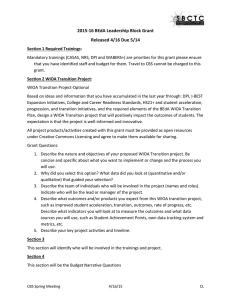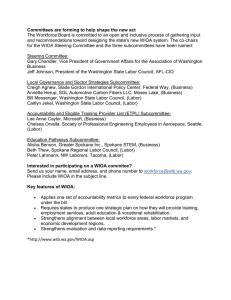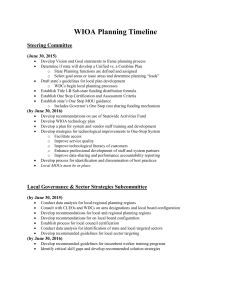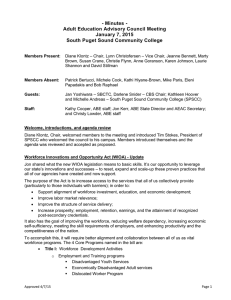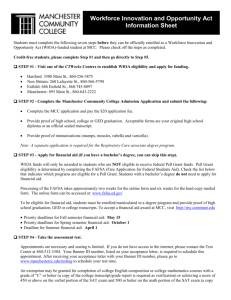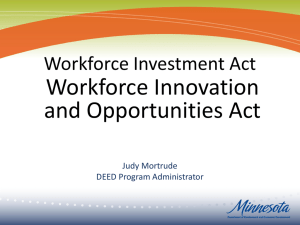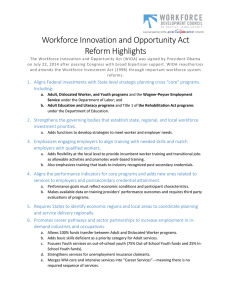Workforce Innovation and Opportunity Act (WIOA)
advertisement
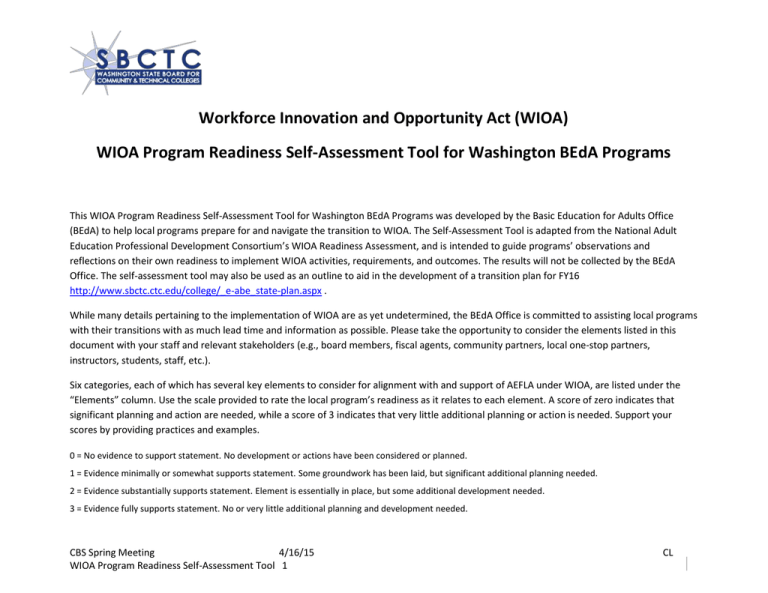
Workforce Innovation and Opportunity Act (WIOA) WIOA Program Readiness Self-Assessment Tool for Washington BEdA Programs This WIOA Program Readiness Self-Assessment Tool for Washington BEdA Programs was developed by the Basic Education for Adults Office (BEdA) to help local programs prepare for and navigate the transition to WIOA. The Self-Assessment Tool is adapted from the National Adult Education Professional Development Consortium’s WIOA Readiness Assessment, and is intended to guide programs’ observations and reflections on their own readiness to implement WIOA activities, requirements, and outcomes. The results will not be collected by the BEdA Office. The self-assessment tool may also be used as an outline to aid in the development of a transition plan for FY16 http://www.sbctc.ctc.edu/college/_e-abe_state-plan.aspx . While many details pertaining to the implementation of WIOA are as yet undetermined, the BEdA Office is committed to assisting local programs with their transitions with as much lead time and information as possible. Please take the opportunity to consider the elements listed in this document with your staff and relevant stakeholders (e.g., board members, fiscal agents, community partners, local one-stop partners, instructors, students, staff, etc.). Six categories, each of which has several key elements to consider for alignment with and support of AEFLA under WIOA, are listed under the “Elements” column. Use the scale provided to rate the local program’s readiness as it relates to each element. A score of zero indicates that significant planning and action are needed, while a score of 3 indicates that very little additional planning or action is needed. Support your scores by providing practices and examples. 0 = No evidence to support statement. No development or actions have been considered or planned. 1 = Evidence minimally or somewhat supports statement. Some groundwork has been laid, but significant additional planning needed. 2 = Evidence substantially supports statement. Element is essentially in place, but some additional development needed. 3 = Evidence fully supports statement. No or very little additional planning and development needed. CBS Spring Meeting 4/16/15 WIOA Program Readiness Self-Assessment Tool 1 CL 1. 1.1. 1.2. 1.3. 1.4. Element 0 1 2 3 Program Mission Alignment to WIOA Practices and Examples Notes and Next Steps Our program’s mission is in alignment with the purposes of WIOA, WA State BEdA Transition Plan. Our program’s target population(s) and beneficiaries are those whom WIOA-funded activities are intended to serve. Our governing body (board of directors, host agency, fiscal agent) is cognizant of and supports our program in the implementation of WIOA requirements. Our program and our governing body demonstrate commitment to investing in leadership time to actively guide this transition process. 1.5. Our program’s target population includes adults who need assistance transitioning to career and/or post-secondary education and/or aspire to achieve outcomes related to employment and/or post-secondary education. 2. Governance-Local Boards 2.1. Our regional adult education program leader serves on local workforce investment board (LWIB). 1. Relationship with your local Workforce Development Council: CBS Spring Meeting 4/16/15 WIOA Program Readiness Self-Assessment Tool 2 CL 2.2. 3. a. Where is your local WDC located? b. Who is the director of your local WDC? c. Who on the WDC board speaks for your college or organization? d. What is your relationship/influence? 2. What steps are you taking with your WDC that reflect the role of basic education as a Core Program? Our adult education program leader serves on a committee/working group on the local WIB and/or WIOA Implementation Committee, or taskforce. Element 0 1 2 3 Cross-Agency Partnerships and Roles 3.1. Our program has participated in discussions with WIOA Partners. 3.2. Our program has a working relationship with local employers related to learner and community/workforce needs. 1. What relationships do you have with local employers representing in-demand industry sectors or occupations as identified in the Monthly Employment Demand Report from Employment Security? a. Name the employers and identify the nature of the relationship. CBS Spring Meeting 4/16/15 WIOA Program Readiness Self-Assessment Tool 3 Practices and Examples Notes and Next Steps CL 3.3. Our program’s MOU with workforce center(s) and WIOA partner(s) includes: Services to be provided through the onestop system Services to be provided by the adult education provider Methods of referral for partner services Duration of MOU Shared costs and the resources that will support those costs 4. Performance Accountability System 4.1. Our agency has procedures in place for accurate and timely collection of learner data. 1. Sharing gains and services with WIOA partners, including One-Stops: a. How are you reporting academic gains to your WorkSource partner? b. How is your WorkSource partner reporting employment gains to you? c. Do you have an MOU with your WorkSource partner? d. If so, how does it address: i. Services to be provided through one-stop system ii. Services to be provided by basic education for adults iii. Methods of referrals for partner services iv. Shared resources that CBS Spring Meeting 4/16/15 WIOA Program Readiness Self-Assessment Tool 4 CL Pathways and activities are designed to meet the WIOA mandates for one set of performance measures for all core programs. This single set of metrics includes: The percent of program participants who are in unsubsidized employment during the second quarter after exit. The percent of program participants who are in unsubsidized employment during the fourth quarter after exit. The median earnings of participants who are in unsubsidized employment during the second quarter after exit. The percent of participants who obtain a recognized postsecondary credential or a secondary diploma or its recognized equivalent during participation in or within one year of exit. The percent of participants who during the program year are in education or training that leads to a recognized postsecondary credential or employment and who are achieving measurable skill gains towards such a credential or employment. The indicators of effectiveness in serving employers. CBS Spring Meeting 4/16/15 WIOA Program Readiness Self-Assessment Tool 5 CL 4.2. 4.3. 5. 5.1. 5.2. 5.3. Our program is positioned to be evaluated and to demonstrate success based on the required WIOA outcome measures, federal EFL targets, and Student Achievement (SAI) measures. Our program is engaged in or prepared to be engaged in discussions with workforce partners to support integrated intake, case management, and reporting. Element AEFLA/BEdA Activities 0 1 2 3 Practices and Examples Notes and Next Steps Our program has activities in place to support the development and implementation of effective and accessible career pathways. 1. How do you address college and career pathways: a. At intake with ABE students? b. At intake with ESL students? c. On an ongoing basis with all students? Program instructional standards (CCRS) aligns to K-12 outcomes and provides students with the skills to be college ready. Our program provides contextualized instruction in all courses and modalities. 1. In order to meet the requirement that employability skills are taught at all levels, what skills are being taught: a. In lower-level ABE classes? b. In lower-level ESL classes? CBS Spring Meeting 4/16/15 WIOA Program Readiness Self-Assessment Tool 6 CL c. In higher level ABE clases? d. In higher level ESL classes? e. In high school completion classes, including HS 21+? 5.4. 5.5. 5.6. 5.7. 5.8. 5.9. Our program teaches and assesses speaking and listening skills at all levels in both ABE and ESL. Our program expands the provision for technology to ensure students are skilled at solving problems in technology rich environments. Has a plan in place to transition all EL Civics programming to con-enrolled integrated employment and training activities, e.g., IBEST, I-BEST like programming. Our program has activities and instruction in place (such as employability skills training and career exploration) to support workforce preparation. Needs of local employers/industries are integrated into program design and delivery. Our program can identify current apprenticeship programs and career pathways in place in our community. 1. Integrated instruction: a. What I-BEST programs are currently approved on your campus? b. What I-BEST offerings to you currently have? c. Which are available to ESL students? CBS Spring Meeting 4/16/15 WIOA Program Readiness Self-Assessment Tool 7 CL d. What are your plans for expanding IBEST, especially for ESL students? 6. AEFLA Grant Considerations 6.1. Our program can demonstrate ability to serve eligible individuals with disabilities, including learning disabilities. Our program can demonstrate responsiveness to regional needs (i.e. local needs assessments, emerging sectors) Our program can demonstrate commitment to serving individuals most in need. Our program can demonstrate past effectiveness in improving literacy skills. Our program will align its proposed activities and services with strategies and goals of the local plan and services of one-stop partners. Our program can demonstrate that proposed instruction is of sufficient intensity and quality so that participants achieve substantial learning gains. 6.2. 6.3. 6.4. 6.5. 6.6. Element 0 1 2 3 Practices and Examples Notes and Next Steps 6.7. Our program uses instructional practices that include the essential components of reading instruction. 6.8. Our program can offer adult education activities based on best practices, derived from research. 6.9. Our program demonstrates use of technology that leads to improved performance. 6.10. Our program provides basic skills learning in CBS Spring Meeting 4/16/15 WIOA Program Readiness Self-Assessment Tool 8 CL 6.11. 6.12. 6.13. 6.14. 6.15. context, including through integrating basic education with career training, to assist in learners’ transition to postsecondary education and obtaining employment. Our program employs instructors who meet minimum qualifications as defined by CDE/AEFL guidance and policy. Our program coordinates with other education, training, and social service resources in the community.1 Our program offers flexible schedules and coordinates with support services necessary to enable individuals to attend and complete program.2 Our local area has a demonstrated need for additional English language acquisition and civics education programs. Our program aligns curriculum with stateadopted academic standards (CCRS for ABE/ASE adult learners). 1 “with elementary schools and secondary schools, postsecondary educational institutions, institutions of higher education, local workforce investment boards, one-stop centers, job training programs, and social service agencies, business, industry labor organizations, community-based organizations, non-profit organizations, and intermediaries, for the development of career pathways.” (Workforce Innovation and Opportunity Act) 2 “eligible provider’s activities offer flexible schedules and coordination with Federal, State, and local support services (such as child care, transportation, mental health services, and career planning) that are necessary to enable individuals…” (Workforce Innovation and Opportunity Act) CBS Spring Meeting 4/16/15 WIOA Program Readiness Self-Assessment Tool 9 CL Definitions from Pub. L. 113–128, Workforce Innovation and Opportunity Act; Pub. L. 113–128, title II, Adult Education and Family Literacy Act CAREER PATHWAY—The term ‘‘career pathway’’ means a combination of rigorous and high-quality education, training, and other services that— (A) aligns with the skill needs of industries in the economy of the State or regional economy involved; (B) prepares an individual to be successful in any of a full range of secondary or postsecondary education options, including apprenticeships registered under the Act of August 16, 1937 (commonly known as the ‘‘National Apprenticeship Act’’; 50 Stat. 664, chapter 663; 29 U.S.C. 50 et seq.) (referred to individually in this Act as an ‘‘apprenticeship’’, except in section 171); (C) includes counseling to support an individual in achieving the individual’s education and career goals; (D) includes, as appropriate, education offered concurrently with and in the same context as workforce preparation activities and training for a specific occupation or occupational cluster; (E) organizes education, training, and other services to meet the particular needs of an individual in a manner that accelerates the educational and career advancement of the individual to the extent practicable; (F) enables an individual to attain a secondary school diploma or its recognized equivalent, and at least 1 recognized postsecondary credential; and (G) helps an individual enter or advance within a specific occupation or occupational cluster. INTEGRATED EDUCATION AND TRAINING— The term ‘‘integrated education and training’’ means a service approach that provides adult education and literacy activities concurrently and contextually with workforce preparation activities and workforce training for a specific occupation or occupational cluster for the purpose of educational and career advancement. INTEGRATED ENGLISH LITERACY AND CIVICS EDUCATION— The term ‘‘integrated English literacy and civics education’’ means education services provided to English language learners who are adults, including professionals with degrees and credentials in their native countries, that enables such adults to achieve competency in the English language and acquire the basic and more advanced skills needed to function effectively as parents, workers, and citizens in the United States. Such services shall include instruction in literacy and English language acquisition and instruction on the rights and responsibilities of citizenship and civic participation, and may include workforce training. WORKPLACE ADULT EDUCATION AND LITERACY ACTIVITIES — The term ‘‘workplace adult education and literacy activities’’ means adult education and literacy activities offered by an eligible provider in collaboration with an employer or employee organization at a workplace or an off-site location that is designed to improve the productivity of the workforce. WORKFORCE PREPARATION ACTIVITIES — The term ‘‘workforce preparation activities’’ means activities, programs, or services designed to help an individual acquire a combination of basic academic skills, critical thinking skills, digital literacy skills, and self-management skills, including competencies in utilizing resources, using information, working with others, understanding systems, and obtaining skills necessary for successful transition into and completion of postsecondary education or training, or employment. CBS Spring Meeting 4/16/15 WIOA Program Readiness Self-Assessment Tool 10 CL
